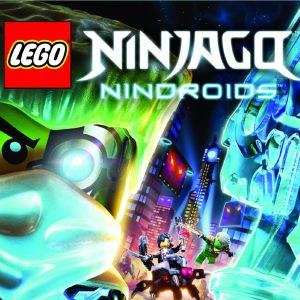
The Lego series of games have built up a strong following and become very popular with a huge number of gamers, helped along by some pretty hefty franchises in the shape of such names as Harry Potter, The Hobbit and numerous superhero titles. One of the great elements of these games is how accessible they are to both experienced and younger gamers, with a 35 year old gaming veteran having every bit as much fun as a 6 year old newbie, so the idea of having a separate branch of Lego games specifically for younger gamers does raise a bit of a question: what’s the point?
That’s what I was asking myself when I loaded up Ninjago Nindroids, my first experience of this alternative style of Lego titles. Based on the range of Ninjago Lego sets (which in turn had a US TV show based on them as well as an upcoming film) I’d expected this to be a very decent game – after all it’s a Lego game based on Lego, there’s no need to even adapt a non-Lego film to suit the surroundings. But there’s something about Nindroids that just doesn’t sit quite right, and it took me a while to realise that the biggest problem was actually my very first thought.
But we’ll get back to that later. The game works in a similar, but very cut-down way to the larger Lego titles – you control a range of characters with different abilities and attacking styles, and use your building skills to make your way through levels, collecting as much stuff as you can find along the way. There are over 30 of these levels to get through all set around the central location of New Ninjago City, although don’t expect to be wandering freely around town, things are far more structured than that. Each level is relatively short, lasting only a few minutes each, and although there are targets to achieve in each level (such as time limits, not losing a life and so on) they’re so short that the desire to go back to improve one each one is fairly limited, and will only really get revisited by those who like to obsess over finishing every last ounce of a game.
Having done some research about the TV show things made a bit more sense, and it’s clear to see that effort has gone into keeping this accurate and appealing to fans of the series, but while there are glimpses of the Lego comedy which we’ve grown to love the storyline and writing as a whole isn’t anything spectacular and won’t stick in the memories of anyone but the most devote Ninjago fan. That’s not helped by the fact that people other than fans of the series won’t know who anyone is, so most of the references to other aspects of the franchise can easily go unnoticed.
To be fair to the developers this is clearly aimed at kids, and I get that. But it’s almost been made too simple, even for kids. Let’s not forget that there’s no way of getting a game over screen in a Lego game – you might get less rewards if you die a lot, but there’s no way of the game giving up on you. In that sense, every Lego game under the sun is young person friendly, which brings us very neatly back to where we started. It took me a while to realise what was a bit wonky about Ninjago Nindroids, but it turns out it was the first thing I thought: what’s the point? It’s smaller than a normal Lego game, it’s not as interesting as a normal Lego game, and it’s got a much narrower audience than a normal Lego game. I accept what was intended for this, but I just struggle to see why this was needed. For young or very inexperienced gamers it’ll be an interesting introduction, but for anyone else just head back towards the fully fledged titles.
Reviewed on PS Vita


Leave a Reply